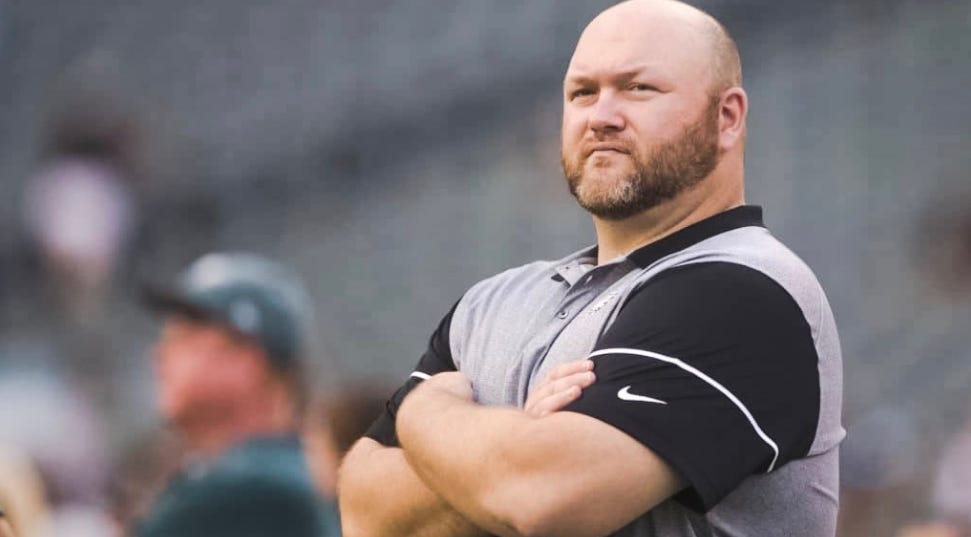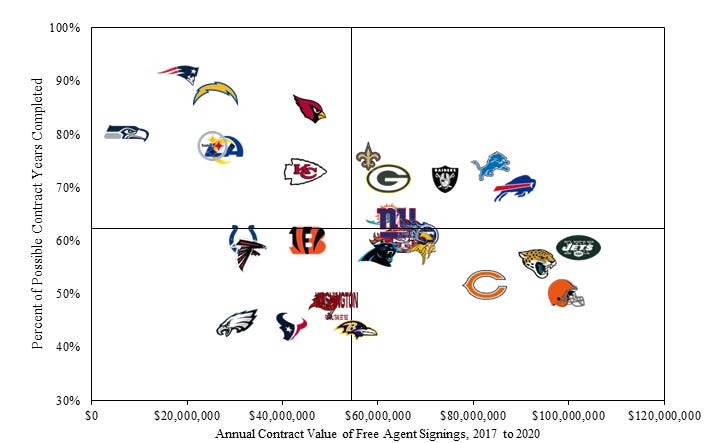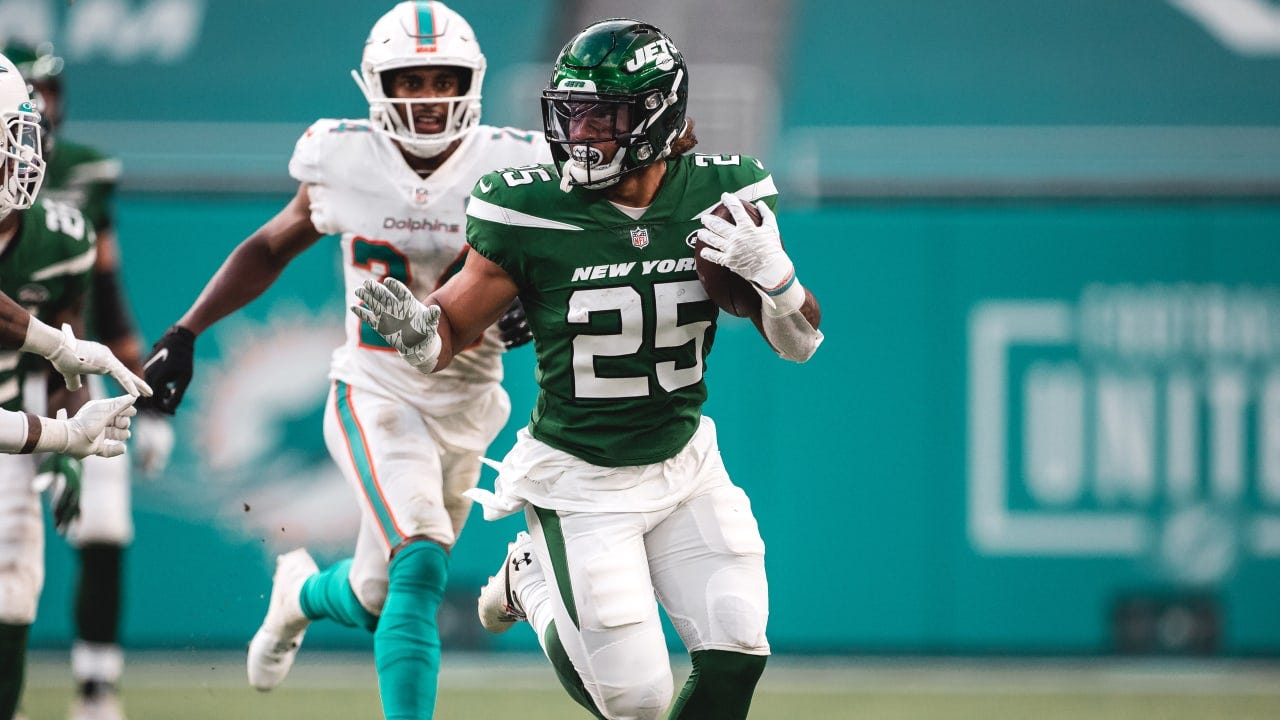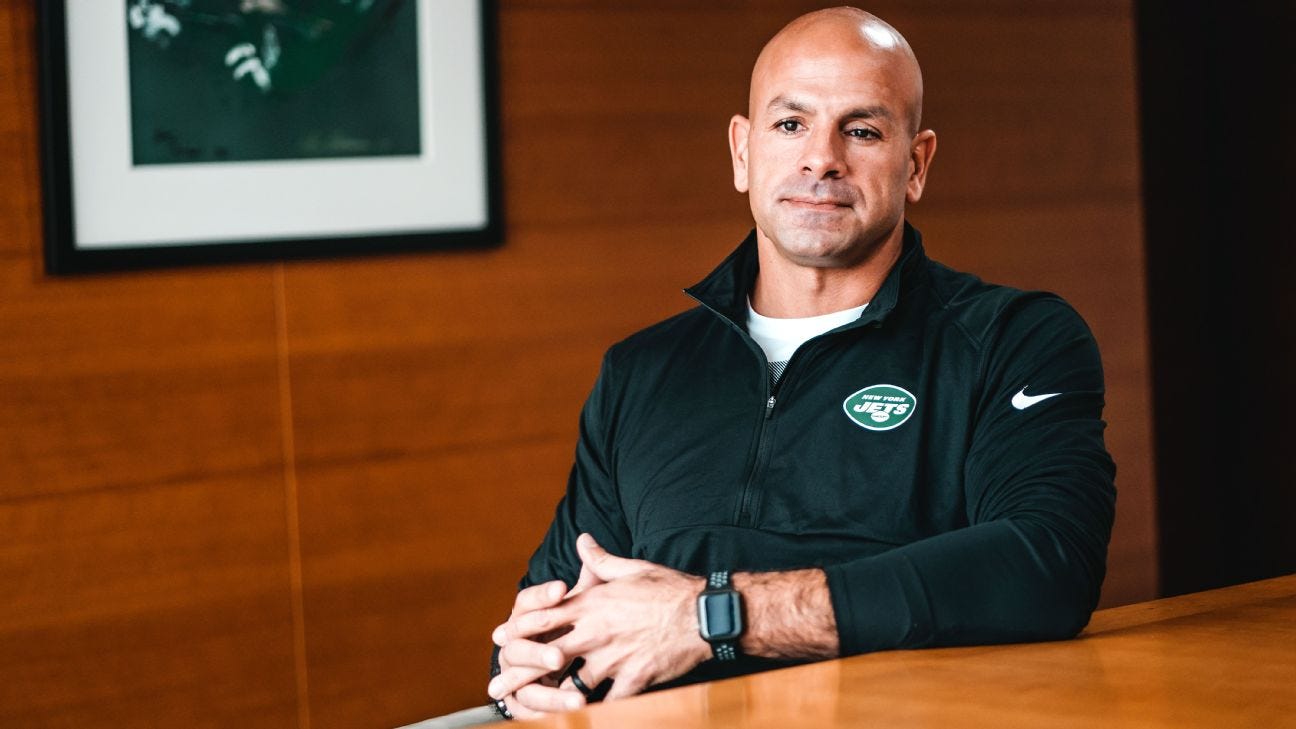This Way Lies Madness
Jets Free Agency Preview: Skill Position Players
Great teams are never built through NFL free agency.
Good teams can see their season improved. Bad teams can see their season mitigated. But it rarely addresses the core issues with a team; that a team hasn’t drafted well enough to build their own core, so they now pick through the leavings of other teams.
Only one team ever won the Super Bowl thanks to free agency and of course 2020 was the exception that proves the rule. Over the last 20 years, the Jets have placed too much emphasis on free agency and they have suffered as a result.
Don’t Build This Way
Need proof? Just look at where the Jets landed on Jason Fitzgerald’s analysis on the subject.
Fat, cap drunk, and stupid is no way to go through life, son.
Having spent the most, and gotten less than average results in contract length alone which stands as a proxy for whether the contract was smart, not to mention actual play, is bad. But that was indicative of the sort of legacy that Mike Maccagnan set up for the Jets.
Why is free agency a bad way to build?
The reasoning is simple: the best teams draft the best players and reserve their best dollars for those best players during NFL players best years of efficiency. That athletic peak generally falls in the 24-30 age window, which obviously aligns with most players’ second contracts after being drafted.
NFL teams who see the most sustained success have a commitment to building through the draft. They keep their very best players and then, by virtue of the team playing at a high level, players who do move on to other teams become their own reward to the original drafting team through the compensatory pick model.
Joe Douglas’s Biggest Test Yet
Ozzie Newsome of the Ravens was famous for building teams in such a manner. That is the model that I have waited for the Jets to employ for decades. The problem of course is that it requires organizational stability and a front office who can — on balance — draft well enough that some players make it to free agency who are desirable to the rest of the league.
Over the next few articles, I’ll buzz through what I wish the Jets would be doing in free agency, with this article focusing on skill positions.
Skill position players are the sum total of the work done by the people around them, the success or failure of the offensive line most notably for running backs, and the relative skill of the quarterback for wide receivers. Is this the place to spend a lot of money when we don’t yet have the answers at line and quarterback?
In that way, aside from the very most talented players, their production has a severe dependency to others on the team, so why pay out a bunch of money for players that could be cheaply replicated through drafting well?
Running Backs
tldr; This newly implemented LaFleur/Shanahan-derived system should prize one-cut runners with extreme speed and burst, but who are ultimately interchangeable and therefore high-dollar players should not be prioritized via free agency.
System: The Shanahan Offense doesn’t covet the traditional 220 pound power running back. This offense values players with ludicrous speed scores, most of whom hover around the 200 pound weight range in order to push their 40 yard dashes into the 4.4x range. With generally lower BMI, these running backs have a tendency to get banged up. Just look at the rotation of starters on the Niners in the last three years.
Roster: The coaching staff has already signaled that they would like Frank Gore to return. As a valuable locker room presence and potential player-coach, Gore’s style isn’t well suited to the likely scheme. Incumbent Ty Johnson seems like the best fit for the scheme. Blessed with 4.45 wheels at 210 pounds, Johnson could have the right blend of speed and power to lead the team’s backfield. But is he talented enough and durable enough to withstand a full season? The Jets are going to have to bring in some outside talent.
Free Agent Clickbait: Kenyan Drake (ARI) could be a fit, but could be another free agent running back at the top of the price pool. Chris Carson (SEA) has been projected as a match for the Jets, but as a larger and sluggish back and with Gore already a target for the team, I don’t see the fit. Phillip Lindsey (DEN) is a little undersized for the scheme, but has the speed and burst to be part of a running back battery.
Better Bargains: Jerrick McKinnon, Tevin Coleman and Matt Breida are obvious easy targets for the Jets due to their ties to former Niners coaching staff. Due to durability concerns, the price might be right for the Jets. But if there was one player I’d like to see wind up on the Jets it would be Duke Johnson (HOU). For whatever reason, he’s not latched on with the right team despite size, speed, and a proven ability as a pass-catcher. For a cheap and short-term deal he might be a worthwhile depth option for this team.
Looking to April: We’re still waiting for all the metrics, but this RB class is extremely top-heavy with Travis Etienne and Najee Harris leading the way. Of those two, Etienne seems to align best with the Jets system but the requisite first round draft capital seems steep. After that, the class has some intriguing prospects but is nowhere near as deep as previous years. Rather than going the route of overpaying a free agent, the Jets should give Ty Johnson a chance, add bargain free agent depth, and draft a one-cut lower-BMI player who matches their scheme. Jermar Jefferson (Oregon State), Michael Carter (UNC), Kenny Gainwell (Memphis), Trey Sermon (Ohio State), Chuba Hubbard (Oklahoma) or maybe even Jarret Patterson (Buffalo) are all players I will be watching closely over the next month as Pro Day measurements trickle in.
Wide Receivers
tldr; A lot of this hinges on how the front office and coaching staff feels about Denzel Mims. However they feel about Mims, the Jets still need to add a versatile and experienced stretch-flanker type before the draft.
System: With players like Deebo Samuel and Brandon Aiyuk, the Shanahan system has moved away from traditional “X” and “Y” receiver types to something more akin to an “XY” amalgamation. This “positionless” receiver type is personified in the league by players like Stefon Diggs or Chris Godwin; they possess just enough size to muscle up on the boundary, but enough elusiveness to pinch inside and burn slot corners. Beyond this “XY” receiver type, the offense still seems to prize traditional “Stretch-Z” flanker types who can benefit from pre-motion, be brought in the backfield on reverses or sweeps, work the boundaries to pull coverage, or get sickeningly open on broken plays.
Roster: We saw flashes last year from Denzel Mims who has the size to contest catches against top cornerbacks and the speed to work inside against anyone. Jamison Crowder played commendably, but at 5’8” 185 pounds we saw last year that even in an Adam Gase “slot funnel” offense, Crowder isn’t the sort of receiver to build an offense. The Jets just brought back Vyncint Smith who has the right versatile profile with enough size and speed. The big knock on Smith was his lack of utter dominance playing at Limestone
Free Agent Clickbait: There’s a lot of talk about the Jets and their interest in Juju Smith-Schuster. I’ll admit it has me worried and hopeful at the same time. I’m worried because Smith-Schuster was the third-best receiver on his team in 2020 and those numbers are supported by his lack of air yards (57th in 2020) and his efficiency (65th in DYAR and 70th in DVOA in 2020) has been bad since Antonio Brown left Pittsburgh. I guess I’m hopeful because if he’s paired with Denzel Mims and gets to work out of the slot, it could give the Jets the most impressive receiver corps since Brandon Marshall and Eric Decker. The problem is of course the pricetag to acquire Smith-Schuster. I doubt it will be worth it and I expect it to be painful. But of him or Kenny Golladay, I guess I’d prefer Smith-Schuster, who is three years Golladay’s junior.
Better Bargains: I’d prefer the Jets go after either Curtis Samuel or David Moore. Samuel will probably command close to $10 million per year and would be an upgrade from Breshad Perriman but would allow room for Denzel Mims to take the alpha receiver’s chair. Samuel can be helpful in other ways. Last year Samuel carried the ball 40 times, can win underneath, is able to separate against single coverage, and could add serious value vertically with his 4.31 40 yard dash speed. Based on the poor QB play in Carolina during Samuel’s tenure, there’s unmined value. David Moore has been overshadowed by Tyler Lockett and DK Metcalf in Seattle. Moore overperformed against his opportunity. Moore only played 24% of his snaps in the slot last year, so with 6’1” and 220 pound size, he could be a great blocker for the Jets stretch-zone system.
Looking to April: Until I see their 40 times, spare me the Alabama wide receiver talk. I just can’t trust expending a first round pick on either Devonta Smith or Jaylen Waddle — two players with diminutive size who benefitted from some impressive QB play on a championship team. With a late first, I would be very interested to see the Jets draft Rashod Bateman (Minnesota), a player who checks every box for me going into the NFL Draft. If Bateman goes before the Jets can select, the Jets should wait until the second or third round for someone like Terrace Marshall (LSU) or Sage Surratt (Wake Forest). If the Jets sign a player in free agency and prioritize a stretch-z type, then I would consider drafting Rondale Moore (Purdue) or Elijah Moore (Ole Miss). I am also falling in love with a guy who is projected to go in the third or fourth, UNC’s Dyami Brown who was overshadowed by the play of the team’s running backs.
Quarterback
tldr; It’s safe to bet that the Jets next QB will come from the 2021 NFL Draft. If they really do believe in Sam Darnold, this new Jets regime has an odd way of showing it.
System: Robert Saleh has been clear that his staff won’t cling to scheme as a crutch, but will but make no mistake, Saleh will use a distinct and simple style of play to help turn this team around. When it comes to offense? Based on the coaches he has picked to come aboard, it sure looks like a Shanahan style offense. As I wrote about extensively last time, this scheme relies on quarterbacks who have excellent mid and long range accuracy. The idea here is that completing a 2nd or 3rd and 8 for a first down is prioritized over hitting a 3rd and 4 like in the West Coast Offense. If they are using the Shanahan playbook, the Jets will want a mobile platform who can extend a play with his legs, is durable enough to take some shots from aggressive linebackers near the boundaries, and still complete those slower developing 10+ yard plays again and again.
Roster: It would seem that the Jets have done their homework and they seem ready to move on from Sam Darnold. The irony is that Sam Darnold has done some of his best work while on the move bootlegging outside the pocket. I guess it doesn’t help that the Jets pocket has been sewn shut during Darnold’s three years with the team. The team was tight-lipped last season and through February about their plans for Darnold. That seems to have changed slightly with Joe Douglas’s public comments on Darnold from a few weeks ago. With Joe Flacco headed to free agency, there’s no one else on this roster who is more than a camp arm.
Free Agent Clickbait: The open landscape of a month ago has been wiped out. Starting with the Goff-Stafford trade and then the Wentz trade some big pieces locked into place. Then Big Ben, Cam Newton, and Dak Prescott all will be staying with their teams. Lastly, Drew Brees and Philip Rivers announcing their retirements took more players off the board. And now we’re in a bit of a lull. Sam Darnold is still dangling and so is Dehaun Watson. Teams who were QB thirsty have snapped up their players already and the remaining shoppers seem to be more discount-minded in the lead-up to the NFL Draft. If the Jets were to just let Sam languish on the roster, walk in free agency in a year, and then collect a compensatory pick it might net them a fourth rounder or maybe even a third in 2023. Assuming Sam turns into a compensatory fourth, that future discount value store equates to a late second rounder this year.
Better Bargains: If I were the Jets, I would have a contract in principle already with Joe Flacco, who I am sure is more interested in testing the market. Flacco knows that at best he’d be the second quarterback in New York; he can read the writing on the wall with a new coaching staff and another potential quarterback being added to the team with the second overall pick. Beyond Flacco there’s not much else out there other than Jacoby Brissett which would (similar to Flacco) feel like empty calories against the Jets cap.
Looking to April: The Deshaun Watson possibility remains open, but likely nothing would happen on that front until the week of the NFL Draft at this point as teams are prepping for free agency. The hilarious part of this, is that the longer this plays out, the more valuable draft picks become to teams (rookie derangement syndrome) and the more the Texans will have to eat from a cap perspective to trade Watson.
As far as rookies? If the Jets stick at #2 then they have to decide whether, as Bucky Brooks recently put it, they want the talent or they want the skills.
There is a difference between talent and skills and as an evaluator you have to be able to separate the talent from the skills. Talent is the natural raw ability … [while] skills are playing the position.
[…]
When I look at Zach Wilson, I see him as the more skilled player … Justin Fields is a talent.
That’s what it comes down to for me. Going into the Draft Zach Wilson looks like a safer player with a lower upside, heightened by the level of competition he played against. On the other hand, Justin Fields seems like he has more potential, but per Brooks the question is whether he can learn more skills to go with the talent.
Coming next, Offensive Linemen and Tight Ends.
Please share this article with your friends!





